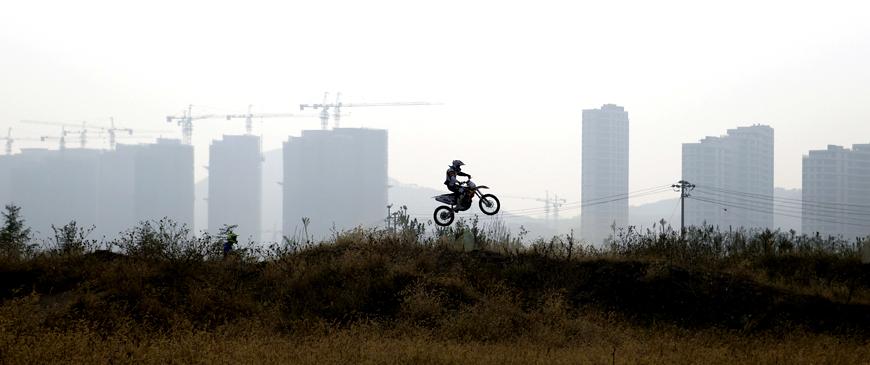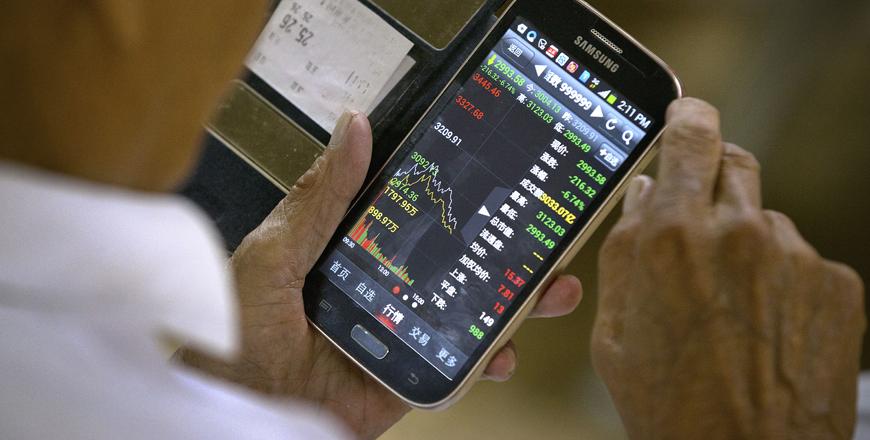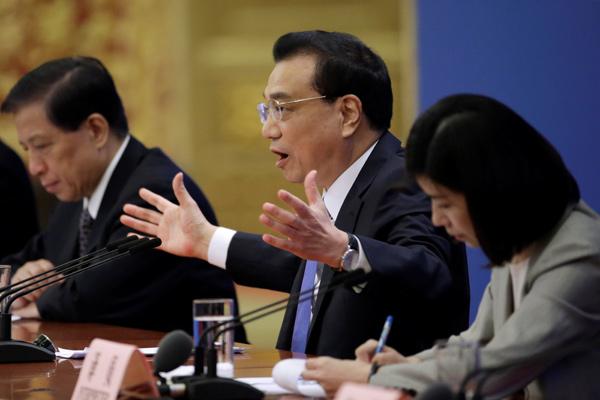You are here
China cuts interest rates again
By Agencies - Oct 24,2015 - Last updated at Oct 24,2015

A motorcyclist practises near buildings in construction in Qingdao, Shandong province, China last week. Home prices in China rose for a fifth consecutive month in September, suggesting a mild recovery in the housing market that will relieve some pressure on the struggling economy (Reuters photo)
BEIJING — China's central bank cut interest rates on Friday for the sixth time in less than a year, and it again lowered the amount of cash that banks must hold as reserves in a bid to jump start growth in its stuttering economy.
Monetary policy easing in the world's second-largest economy is at its most aggressive since the 2008/09 financial crisis, as growth looks set to slip to a 25-year low this year of under 7 per cent.
Yet, underscoring China's drive to deepen financial reforms which many believe are necessary to invigorate the economy, the People's Bank of China (PBoC) said it was freeing the interest rate market by scrapping a ceiling on deposit rates.
The change, which Beijing had promised to deliver for months, will in theory allow banks to price loans according to their risk, and remove a distortion to the price of credit that analysts say fuels wasteful investment in China.
China's policy loosening came a day after the European Central Bank said it could give a bigger policy jolt to the economy as soon as December to fight falling prices.
"We've got half the world's central banks in easing mode," said Joe Rundle, the head of trading at ETX Capital in London. "And we'll probably see more easing from China to come."
The PBoC said on its website that it was lowering the one-year benchmark bank lending rate by 25 basis points to 4.35 per cent, effective from October 24. The one-year benchmark deposit rate was lowered by 25 basis points to 1.5 per cent.
The reserve requirement ratio (RRR) was also cut by 50 basis points for all banks, taking the ratio to 17.5 per cent for the biggest lenders, while banks that lend to agricultural firms and small companies received another 50-basis-point reduction to their RRR.
The late-evening moves come just ahead of a high-level meeting in Beijing starting on Monday where senior Chinese leaders will thrash out the country's economic blue-print for the next five years.
Investors in Europe took cheer and shares soared, while the Chinese offshore yuan fell against the US dollar.
"In the next step, monetary policy ... will be kept not too loose or too tight to ensure stable economic growth," the PBoC said in a separate question-and-answer session.
It added that China's current muted consumer inflation and falling market interest rates provided a window for the country to liberalise its deposit rates.
Sobering data
It has been a tumultuous year for China's economy.
A summer stock market plunge and shock devaluation of the yuan in August roiled global markets and fanned fears of a hard landing, prompting Chinese leaders to take drastic measures to assure investors they have the economy under control.
Friday's easing came minutes after Premier Li Keqiang was quoted on state radio as saying that China will make "reasonable use" of rate and RRR cuts to keep its economy growing at a reasonable pace.
Senior Chinese leaders do not usually comment directly on the country's rate or RRR adjustments.
The cuts came in the same week as sobering economic data for the third quarter that demonstrated the daunting challenges faced by the country's leaders, not least in achieving a growth target of around 7 per cent set by the government.
Data released on Monday showed China's economy grew 6.9 per cent between July and September from a year earlier, dipping below 7 per cent for the first time since the global financial crisis.
With Chinese imports tumbling for the 11th straight month in September and producer prices stuck in deflation for more than three years, some analysts say China's policy makers have their work cut out.
"We're still waiting for clear evidence of an economic turnaround," analysts at Capital Economics said in a note to clients. "We are retaining our forecast that benchmark rates and the reserve requirement ratio will both be cut once more before the end of the year, with a further move in both early in 2016."
According to a top PBoC policy maker, China will be able to keep annual economic growth at around 6-7 per cent over the next three to five years.
The comments from Yi Gang, vice governor of the PBoC, appeared to be aimed at reassuring investors this level of growth, China's slowest pace in two decades but still faster than other major economies, is the Chinese economy's "new normal".
"China's future economic growth will still be relatively quick. Around seven, six-point-something. These will all be very normal," he told a conference in Beijing.
Yi said China in the future would lower the reserve requirement ratio for banks, the amount of cash that major lenders need to keep on hand — at a "normal" pace.
"Our reserve requirement ratio is still at a relatively high level so there is still room to lower the RRR. In future, we will proceed to lower the RRR at a normal pace," he added.
Yi elaborated that the PBoC planned to keep interest rates at a reasonable level to reduce the corporate debt burden, and noted that interest rate liberalisation does not mean that the central bank would reduce regulation of rates.
China will also continue to set benchmark lending and deposit rates for some time, he stated, but these rates would not restrict market pricing.
Yi noted that China's stock market, which has fallen sharply since June, had completed most of its adjustments and that the yuan, which was buffeted in the wake of a surprise devaluation in early August, had "basically" stabilised.
"Following August 11, our original intention was to pursue market reforms. But after that, we realised there was a relatively big depreciation pressure [on the yuan], and so we decided to resolutely stabilise the yuan," he explained.
The PBoC was looking into leverage levels in the debt market, Yi remarked.
He said China did not have exceptionally high debt levels, and while the bank was not overly anxious about cutting the level of leverage in the economy, the overall strategy is to stabilise leverage levels.
"I want to especially mention this: I am now also focused on the leverage level in China's debt market," he concluded.
Separately, China is seeking to assert its growing influence on global oil markets with a yuan-denominated crude futures contract expected to be launched this year.
At the same time, analysts warn that the second-largest oil consumer after the United States will struggle to compete with more established benchmarks such as London's Brent North Sea crude and New York's WTI.
"China is the world's largest oil importer and is going to become the largest oil consumer in the future, so it makes sense for the country to be the place for an oil futures [contract] in Asia," Lin Boqiang, director of the Energy Economics Research Centre at Xiamen University, told AFP.
China's consumption will exceed that of the United States by 2034, according to the US Energy Information Administration.
The country produced about 4.6 million barrels per day (mbpd) of oil in 2014, while the country's average net imports reached 6.1 mbpd.
The influence of Asia, and China in particular, has been growing on international commodity markets in recent times.
"China's vision is to have these commodity markets priced on its own exchanges," said Daniel Colover, associate editorial director at price reporting agency Platts.
It is also consistent with China's gradual moves towards greater internationalisation of its currency.
The Shanghai International Exchange is working on a final draft to be approved by the China securities regulatory commission before a comprehensive mock trading exercise. Market participants expect an official launch by the end of 2015.
Liquidity is key
The initial target of the new contract seems to be local companies and foreign companies with large interests in China, even if trading will be open to international players.
"Part of the reason China wants to launch this contract is to allow domestic hedging" that would protect against local price volatility, according to Wiktor Bielski, global head of commodities research at VTB Capital.
But the contract could struggle with liquidity, especially if it fails to attract foreign investors, as according to Boqiang, "there are not many players on the Chinese oil market, since the sector is highly monopolised".
The Chinese oil sector is dominated by the country's national oil companies and even if some private companies have emerged, their scope remains limited.
"I don't know why someone doing business outside China would be interested, given the longer-established, more transparent and more liquid alternatives are already available elsewhere," said Julian Jessop, head of commodities at research group Capital Economics.
Two-thirds of the world's oil is currently priced against the Brent benchmark.
Market influence
Some grey areas remain around plans for the contract, in particular the crude which is going to be used as underlying instrument.
The derivative, or promise to take or make delivery of a volume of crude at a future date, will be based on a medium and sour crude, a quality favoured in Asia and imported mainly from the Middle East. Thus supply will likely continue to be influenced by external factors.
"A lot of people in the industry, a cross section of the oil market, trading houses, oil majors, producers, are keen to see how it behaves and how it is adopted," said Colover.
For Bielski, market adoption should not be a major hurdle. In fact, volumes on the exchange could develop very quickly thanks to retail investments, he said.
Plans for smaller lot sizes, 100 barrels versus 1,000 for Brent, seems to be tailored to retail investors.
According to Bielski, the iron ore futures contract on the Dalian Commodity Exchange, which influences the price of steel, did not trade for the first six months, but volumes then "exploded" on the back of "punters" trading.
In China, the amount of liquidity available to retail investors with money is growing faster than the number of products they can invest in, he added.
"What if that same thing happens to oil? Chinese markets are going to become more dominant and more importantly they are going to export contagion risk," predicted Bielski.
Related Articles
SHANGHAI/BEIJING — China's central bank cut interest rates and lowered the amount of reserves banks must hold for the second time in two mon
SHANGHAI — China's yuan hit a four-year low on Wednesday, falling for a second day after authorities devalued it, and sources said clamour i
BEIJING — The Chinese government has additional monetary policy measures that it can take to support economic growth this year, and will eve
















